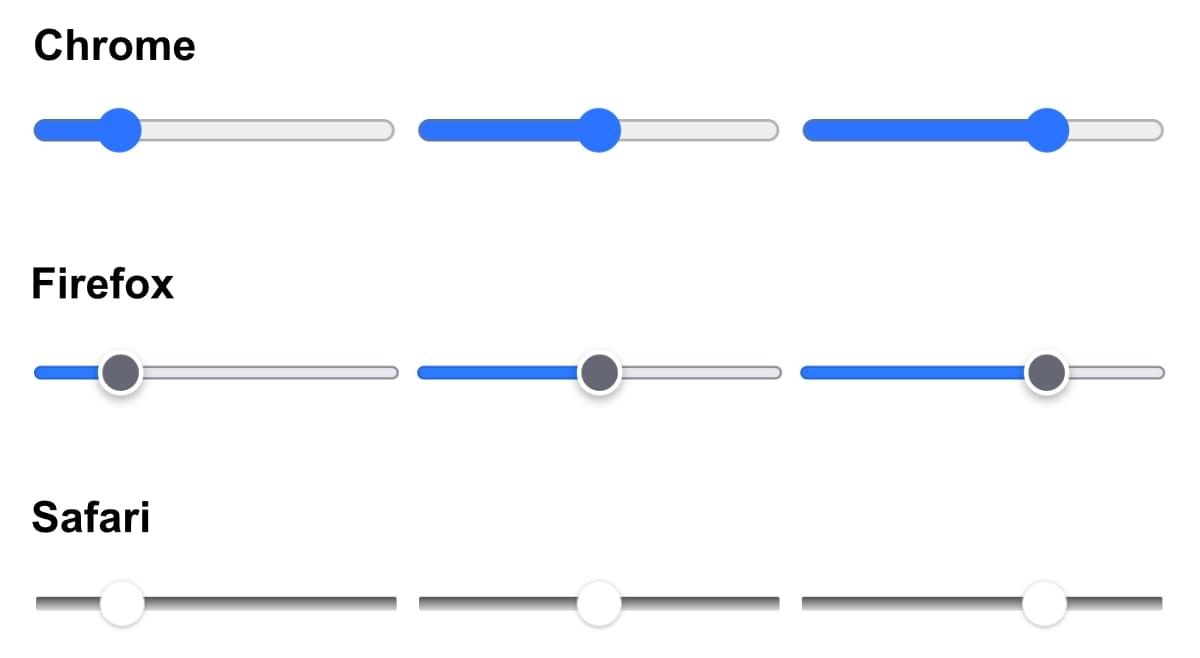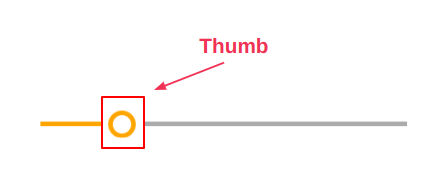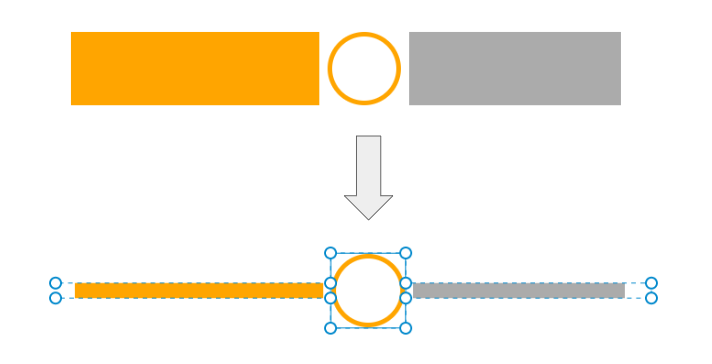On this article, I’ll present use fashionable CSS strategies to create an eye catching, customized vary slider with nothing however the native HTML <enter> factor.
Vary sliders (<enter kind="vary">) let customers select a worth inside a given vary, offering another enter sorts comparable to <enter kind="quantity">.
The default vary slider kinds don’t look nice. The picture beneath provides an thought of how vary the sliders we’ll be styling are displayed by default in Chrome, Firefox and Safari.

However <enter> parts are onerous to type. A lot of the on-line options for styling them depend on JavaScript and a few cluttered code. Worse nonetheless, a few of these strategies additionally break the accessibility of the factor.
So let’s have a look at do issues higher, utilizing simply CSS, and with out compromising accessibility. The CodePen demo beneath reveals what we’ll be constructing.
See the Pen
CSS solely customized vary sliders by Temani Afif (@t_afif)
on CodePen.
Cool proper? You’ll additionally discover variations on these kinds on the finish of the article!
The Construction of the Vary Enter Ingredient
Let’s begin by dissecting the construction of the vary enter factor. It’s a local factor, and every browser has its personal implementation of such parts. We primarily have two totally different implementations.
There’s one for Webkit and Blink browsers comparable to Chrome, Edge, Safari, and Opera:
<enter kind="vary" min="0" max="100" step="1" worth="20">
<div>
<div pseudo="-webkit-slider-runnable-track" id="observe">
<div id="thumb">
</div>
</div>
</div>
</enter>

And that is the one for Firefox:
<enter kind="vary" min="0" max="100" step="1" worth="20">
<div></div>
<div></div>
<div></div>
</enter>

There’s a 3rd implementation for IE, however fortunately that browser is all however useless and gone now!
Such inconsistency between browsers is what makes the duty troublesome, as we have to present totally different styling for every implementation. I gained’t dig extra into this, because the article would by no means finish, however I extremely suggest studying this text by Ana Tudor for extra in-depth exploration.
The one factor you want to remember is that, regardless of the implementation, we at all times have the “thumb” as a standard part.

I’m solely going to type this factor, which is able to make my customized vary slider simple to customise. Let’s leap straight into the code to see the magic in play.
Customizing the Enter
Step one is to reset and disable all of the browser default kinds by utilizing look: none and another frequent properties:
enter {
look :none;
background: none;
cursor: pointer;
}
In a extra difficult situation, we might have so as to add extra code in case different default kinds are utilized to our factor. Merely simply want to verify now we have a “bare” factor with none visible styling.
Let’s additionally outline a number of CSS variables so we are able to simply create totally different variations for the vary slider. Don’t fear if a number of the code beneath seems to be complicated. We simply must replace a number of variables to manage our slider:
enter {
--c: orange;
--g: 8px;
--l: 5px;
--s: 30px;
width: 400px;
top: var(--s);
look :none;
background: none;
cursor: pointer;
}
At this step, solely the thumb is seen with its default kinds, because the CodePen demo beneath reveals.
See the Pen
Default enter kinds — by Temani Afif by SitePoint (@SitePoint)
on CodePen.
Styling the Thumb Ingredient
Let’s type the thumb factor. We’ll begin with the essential setup:
<thumb selector> {
top: var(--s);
aspect-ratio: 1;
border-radius: 50%;
box-shadow: 0 0 0 var(--l) inset var(--c);
look: none;
}
The code ought to be self-explanatory. Nothing fancy thus far, and we’ll get the outcome proven beneath.
See the Pen
Styling the thumb — by Temani Afif by SitePoint (@SitePoint)
on CodePen.
Observe the usage of two totally different selectors, as we defined within the first part:
enter[type="range" i]::-webkit-slider-thumb { }
enter[type="range"]::-moz-range-thumb { }
However how have you learnt the selector to make use of?
I’ve merely inspected the code of the enter utilizing the browser’s developer instruments to see the selector every browser is utilizing to type the thumb. The article I shared beforehand reveals you manipulate the developer instruments to get such data.
Including Some Magic with border-image
Now we’re going to make use of a magic CSS trick to finish our slider. It includes the usage of border-image:
border-image: linear-gradient(90deg,var(--_c) 50%,#ababab 0) 1/0 100vw/0 calc(100vw + var(--g));
I do know it seems to be scary, however let’s dissect that line and you will notice it’s not that troublesome. The above is the shorthand for the next:
border-image-source: linear-gradient(90deg,var(--c) 50%,#ababab 0);
border-image-slice: 1;
border-image-width: 0 100vw;
border-image-outset: 0 calc(100vw + var(--g));
From the MDN web page, we learn:
The
border-imageCSS property attracts a picture round a given factor. It replaces the factor’s common border.
Our picture shall be a gradient having two colours — the principle one (outlined by --c), and a grey coloration. We’d like the border picture to cowl the entire house of the enter horizontally, so we use an enormous worth for the left and proper width (100vw) whereas we hold the highest and backside at (0).
However the border-image-width is proscribed to the factor measurement. To beat this, we have to additionally use an enormous worth for the border-image-outset to extend the house obtainable for the border picture. From MDN once more:
The
border-image-outsetCSS property units the space by which a component’s border picture is ready out from its border field.The elements of the border picture which might be rendered exterior the factor’s border field with
border-image-outsetdon’t set off overflow scrollbars and don’t seize mouse occasions.
Whenever you first see the slider, it seems to be like we’re growing the principle coloration on the left, however in actuality we’re sliding a set gradient that’s overflowing our factor.
The next demo offers an outline of what’s occurring underneath the hood.
See the Pen
Overview of the border-image trick by SitePoint (@SitePoint)
on CodePen.
Drag the thumb and slide it to see how issues are shifting. I’m utilizing a small worth for the width and outset so we are able to simply perceive the trick.
Additionally, observe that the outset must be greater than the width to have the hole. Because of this, it’s outlined to be equal to the width plus the worth of the hole.
By including overflow: hidden to the enter factor and utilizing an enormous worth, the phantasm is ideal, as proven beneath.
See the Pen
Vary Slider — overflow: hidden by SitePoint (@SitePoint)
on CodePen.
What in regards to the
border-image-slice? Why the worth of1?
This property is a bit tough, however obligatory when utilizing border-image. In our case, this worth isn’t very related and a small optimistic worth will do the job. I’ve an in depth Stack Overflow reply if you wish to be taught extra about it.
The final step is to lower the dimensions of the bar to match the dimensions we outlined by the variable --l. For this, we’re going to make use of clip-path:
clip-path:
polygon(
0 calc(50% + var(--l)/2),
-100vw calc(50% + var(--l)/2),
-100vw calc(50% - var(--l)/2),
0 calc(50% - var(--l)/2),
0 0,100% 0,
100% calc(50% - var(--l)/2),
100vw calc(50% - var(--l)/2),
100vw calc(50% + var(--l)/2),
100% calc(50% + var(--l)/2),
100% 100%,0 100%);
The picture beneath offers an outline of the totally different factors to know the form of the polygon.

That’s it! We’ve a customized vary slider with a number of strains of code which you could simply management by adjusting a number of variables.
See the Pen
Last Vary Slider — by Temani Afif by SitePoint (@SitePoint)
on CodePen.
Including Some Animation
What about some refined animation once we work together with the slider? It doesn’t want numerous code, and it’ll improve the UX of the slider.
First, we’re going to rework the thumb from a border-only circle right into a full circle once we click on on it. For this, we improve the unfold worth of the box-shadow. Do not forget that we’ve used box-shadow to outline the border of the thumb:
box-shadow: 0 0 0 var(--l) inset var(--c);
We replace the var(--l) to var(--s) utilizing the :energetic selector and the :focus-visible. The latter is said to keyboard navigation and permits us to have the identical impact whether or not we use the mouse or the keyboard.
The code is as follows:
enter[type="range" i]::-webkit-slider-thumb {
box-shadow: 0 0 0 var(--s) inset var(--c);
transition: .3s;
}
enter[type="range" i]::-moz-range-thumb {
box-shadow: 0 0 0 var(--s) inset var(--c);
transition: .3s;
}
enter:energetic::-webkit-slider-thumb,
enter:focus-visible::-webkit-slider-thumb {
box-shadow: 0 0 0 var(--s) inset var(--c);
}
enter:energetic::-moz-range-thumb,
enter:focus-visible::-moz-range-thumb {
box-shadow: 0 0 0 var(--s) inset var(--c);
}
It’s a bit prolonged for a box-shadow transition, proper? We will optimize it utilizing a CSS variable:
enter[type="range" i]::-webkit-slider-thumb {
box-shadow: 0 0 0 var(--_b,var(--s)) inset var(--c);
transition: .3s;
}
enter[type="range" i]::-moz-range-thumb {
box-shadow: 0 0 0 var(--_b,var(--s)) inset var(--c);
transition: .3s;
}
enter:energetic,
enter:focus-visible {
--_b: var(--s);
}
I’m expressing the unfold worth utilizing a variable, and I’m merely updating that variable on :energetic and :focus-visible.
I’m additionally going so as to add just a little animation to the colour. I’ll make it a bit darker on :hover. For this, I gained’t replace the colour, however moderately combine it with black utilizing the brand new color-mix() operate. This trick permits us to make use of the principle coloration outlined by --c moderately than outline a brand new darkish coloration for every slider manually:
--_c: color-mix(in srgb, var(--c), #000 var(--p,0%));
I’m defining a brand new variable that can substitute the --c within the code. Then by adjusting the share of the black coloration (#000) utilizing the variable --p, I’m controlling the “darkness” of the colour:
enter:focus-visible,
enter:hover{
--p: 25%;
}
This characteristic isn’t but supported in each browser, so the usage of a fallback is extremely advisable:
@helps not (coloration: color-mix(in srgb,crimson,crimson)) {
enter {
--_c: var(--c);
}
}
Our vary slider is now excellent!
See the Pen
CSS solely customized vary sliders by SitePoint (@SitePoint)
on CodePen.
Conclusion
We’ve reached the tip and haven’t needed to cope with any complicated browser-related implementation! We recognized the selector of the thumb factor and, utilizing a number of CSS tips, we styled the entire vary slider with it. Let’s not overlook that we did this utilizing solely the <enter> factor, so we don’t have to fret about any accessibility points, as we’ve saved the native performance. The slider helps keyboard navigation with out a drawback.
Listed below are extra examples of sliders utilizing the identical method. I’ll allow you to dissect their code as an train.
See the Pen
Customized Vary Slider — by Temani Afif by SitePoint (@SitePoint)
on CodePen.
See the Pen
Customized Vary Slider — by Temani Afif by SitePoint (@SitePoint)
on CodePen.


